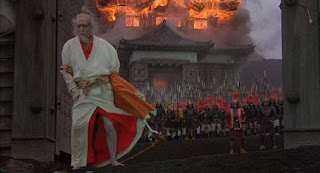
Ran is one of the most epic films ever made, a masterful achievement for director Akira Kurosawa. A loose adaptation of King Lear, the film is set in 16th century medieval
Kurosawa was 75 years old and nearly blind when he was filming Ran, and it’s amazing that the end product is filled with such depth and visual poetry. The film plays much like a visual tone poem, where the colors and landscapes come alive like few films do. Even the weather seems to come alive, as there are multiple shots of ominous clouds overtaking the landscape. The clouds eventually give way into wind and storms, seemingly commenting on the chaos that is destroying the kingdom.
The film’s main setpiece comes about an hour into the film, when the two elder sons have been plotted against each other, and both are storming the castle with the aging warlord trapped inside. One army comes decked in red; the other in yellow. It helps the viewer identify each army, but the colors also create a sort of moving painting. As the ghost-like Hidetora sits at the top of his castle, the armies wage war below. The first part of the battle is done mainly in silence with just the soundtrack playing over the battle, very much creating a poetic scene. Then, a gunshot goes off, and we are brought right back into the battle, the sound effects now reflecting the scene, with swords clashing, horses racing, and battle cries everywhere. The sequence ends on a powerful shot of Hidetora walking down the steps of his burning castle, slowly leaving his kingdom in a trance-like state. No words are needed to convey the weight of the sequence—Hidetora realizes his reign is over and his kingdom will fall at the hands of his own family, and all the wisdom he’s acquired throughout his life will not save him.
As mentioned before, the film is very bleak in its view of humanity. The title ‘ran’ translates to ‘chaos’, which is exactly what the kingdom is experiencing. Hidetora realizes that his power has now been reduced to nothing, as his sons bicker and fight, tearing apart piece by piece the kingdom that he had created. However, Hidetora isn’t necessarily a heroic character himself, as it is referenced earlier that the way he came into power was through murder and other ruthless tactics. Even Saburo, the most honorable son (the only son who expression dissention to his father’s original plan) ends up dying a cheap, pointless death.
Ran is not a particularly fast paced film, but it doesn’t need rush things along to convey its themes. The first hour establishes the characters and how the power in the kingdom isn’t necessarily based on loyalty. The rest of the film is spend tearing down that power, where by the end nothing is sacred and everyone has experienced defeat, whether it be through death or extreme suffering. The final shot of the film shows a blind peasant (the blindness was caused by Hidetora years ago) left all alone near a cliffside. As he inches closer and closer towards the cliff, he barely catches himself before plunging to his death, but the fact still remains that he has nowhere to go and nobody to help him.
Kurosawa directed many masterpieces in his time, and to have yet another near the end of his career proves all the more impressive. Ran remains to this day a masterpiece of visual style and kinetic storytelling.
Rating: 5 stars
No comments:
Post a Comment